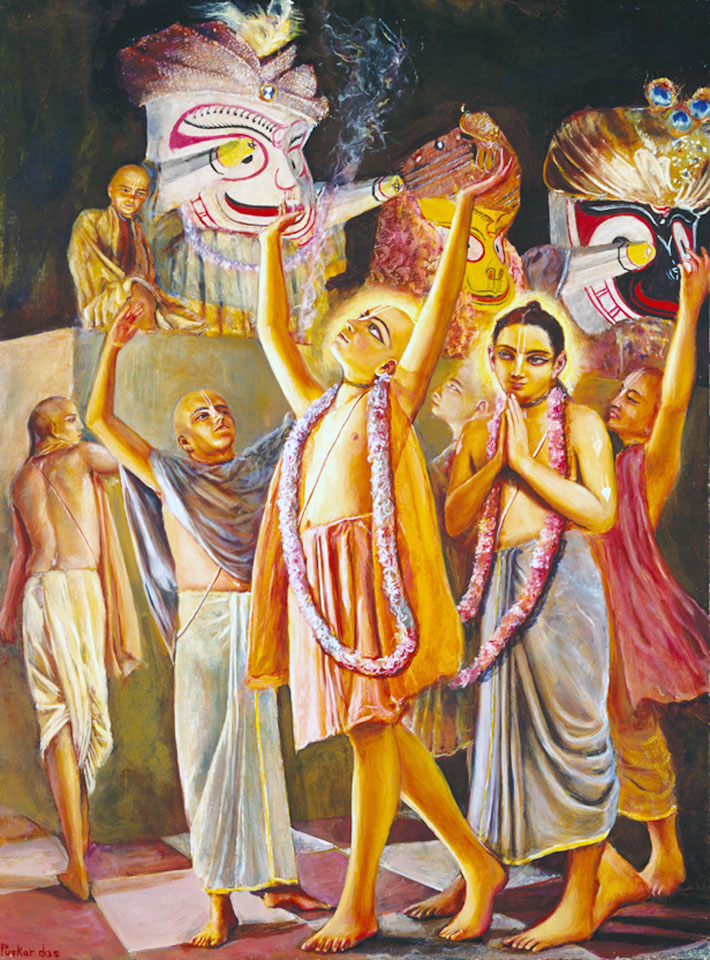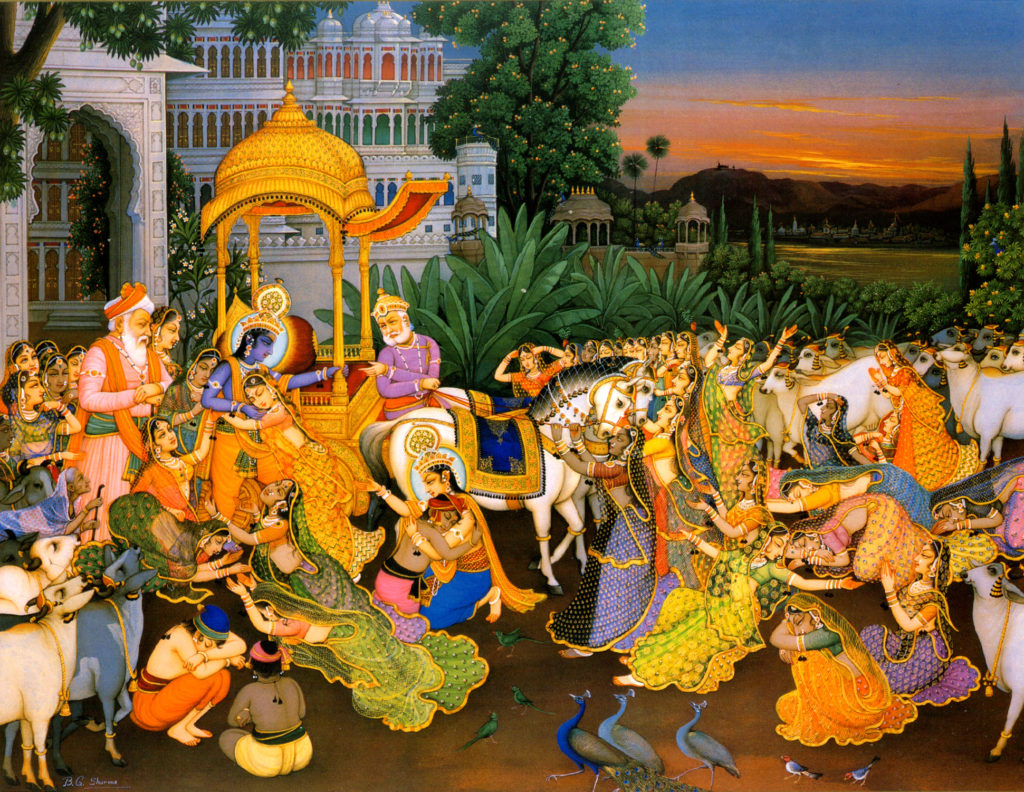In a unique form, Lord Krsna is worshiped in a famous temple In Puri and at Rathayatris there and around the world.
I was born in a conservative Oriyan Vaisnava family in Puri, on the east coast of India. The Supreme Lord Jagannatha and His devotees were at the center of my life.as child, I played with dolls of Jagannatha, Baladeva (Balarama), and Subhadra, the Deities in the famous Puri temple. I still remember how my mother gave me enormous plates of Jagannatha prasadam and told me to always remember the Lord. I saw how the simple and devoted Oriyan people-even doctors, engineers, and scientists-never neglect to honor Lord Jagannatha. I watched how the king of Puri becomes a humble servant and sweeps the street before Jagannatha’s cart during the yearly Ratha-yatra, or festival of the chariots.
Lord Jagannatha may look peculiar and strange to the Western world, but He is the life and soul of the Orissans. Even though I attended the Ratha-yatra festival for many years in my youth, it was not until I met the devotees of ISKCON that my devotion to Jagannatha deepened. Now Jagannatha is worshiped in many ISKCON temples around the world, and I have grown to see Him as the most merciful and charming person who excuses His devotees’ offenses and attracts them further along the path of devotional service.
Jagannatha means “Lord of the universe.” Many Vedic books mention that Jagannatha is Krsna. Baladeva is His brother, and Subhadra is His sister.
Although Krsna is absolute and transcendental to material nature, to accept the loving service of His devotees He appears before us as the Deity in the temple, in the form of stone, metal, wood, or paint. Jagannatha is a wooden form of Krsna.
Because Jagannatha does not look like Krsna, people may wonder how He can be Krsna. Scriptures tell the story behind Jagannatha’s peculiar form.
JAGANNATHA’S TRANSCENDENTAL ADVENT
 The Skanda Purana relates King Indradyumna’s quest to find a deity form of Krsna after dreaming of a beautiful blue Deity named Nila Madhava. The name describes the sapphire color of the deity: Nila means blue, and Madhava is one of Krsna’s names. King Indradyumna sent messengers in all directions to find Nila Madhava, and a brahmana named Vidyapati returned successfully. He discovered that Visvavasu, a pig farmer (Sabara) in a remote tribal village, was secretly worshiping Nila Madhava. When Vidyapati later returned to that place with Indradyumna, however, Nila Madhava was gone. King Indradyumna surrounded the village with his soldiers and arrested Visvavasu.
The Skanda Purana relates King Indradyumna’s quest to find a deity form of Krsna after dreaming of a beautiful blue Deity named Nila Madhava. The name describes the sapphire color of the deity: Nila means blue, and Madhava is one of Krsna’s names. King Indradyumna sent messengers in all directions to find Nila Madhava, and a brahmana named Vidyapati returned successfully. He discovered that Visvavasu, a pig farmer (Sabara) in a remote tribal village, was secretly worshiping Nila Madhava. When Vidyapati later returned to that place with Indradyumna, however, Nila Madhava was gone. King Indradyumna surrounded the village with his soldiers and arrested Visvavasu.
Then a voice from the sky proving Himself in that form out of His own inconceivable desire, to show the world that He can accept offerings without hands, and move around without feet.
Lord Jagannatha told the king, “Know for sure that My hands and feet are the ornaments of all ornaments, but for your satisfaction, you may give Me gold and silver hands and feet from time to time.”
Devotees now worship the same “unfinished” forms of Jagannatha, Baladeva, and Subhadra in Puri and in temples around the world. These forms are part of Their eternal pastimes.
TRANSFORMED BY ROHINI’S TALKS
The Utkala Khanda of the Skanda Pura” gives another account related to Krsna’s appearance as Jagannatha. (Utkala is the traditional name for Orissa.) Once, during a solar eclipse, Krsna, Balarama, Subhadra, and other residents of Dvaraka went to bathe in a holy pond at Kuruksetra. Knowing that Krsna would be there, Srimati Radharani, Krsna’s parents Nanda and Yasoda, and other residents of Vrndavana, who were burning in the fire of separation from the Lord, went to meet Him. Inside one of the many tents the pilgrims had set up at Kuruksetra, Rohini, Lord Balarama’s mother, narrated Krsna’s Vrndavana pastimes to the queens of Dvaraka and others.
The residents of Dvaraka are said to be in the mood of opulence (aisvarya), and they worship Krsna as the Supreme Lord. But the residents of Vrndavana are in the mood of sweetness (madhurya), and they have a confidential relationship with Krsna that surpasses awe and reverence because it is based on friendship and love. Rohini’s narration was thus extremely confidential, so she posted Subhadra at the door to prevent anyone from entering.
Krsna and Balarama came to the door and stood on Subhadra’s left and right sides. While listening to Rohin’s narration of Krsna’s intimate Vrndavana pastimes, Krsna and Balarama became ecstatic, and Their internal feelings were exhibited externally. Their eyes became dilated, Their heads compressed into Their bodies, and Their limbs retracted. Seeing these transformations in Krsna and balarama, Subhadra also became ecstatic and assumed a similar form. Thus, by hearing about Krsna’s pastimes in Vrndavana, Krsna and Balarama, with Subhadra in between, displayed their ecstatic forms of Jagannatha, Baladeva, and Subhadra.
THE LODRD’S HIGHEST ECSTASY
According to the Skanda Purana, the yestha-Purnima, the full-moon day of the month of May-June, is the birthday of Jagannatha. Jagannatha is Krsna, but Krsna’s birthday is Janmashtami, In the month of Bhadra (August-September). This apparent contradiction is resolved if we understand that the yestha-Purnima is the time when Krsna appeared in the form of Jagannatha with big, dilated eyes and shrunken limbs. This is known as mahabhava-prakasa, the ecstatic form of Krsna. Mahabhava means “the highest ecstasy,” and prakasa means “manifestation,” so Jagannatha is literally the ecstatic form of Krsna
The poem Mahabhava Prakasa by the Oriyan poet Kanai Khuntia describes the confidential meaning behind the form of Jagannatha: He is the embodiment of Krsna’s pangs of separation from the residents of Vrndavana, particularly Radha and the gopis. Scriptures explain that intense feelings of spiritual ecstasy, especially in this mood of separation from a loved one, produce transformations in the body. Since Krsna is not different from His body, His internal feeling showed externally, and He assumed the form of Jagannatha.
The ecstasy of mahabhava is compared to an ocean. In the pastime with King Indradyumna, a giant log floated on the ocean. Similarly, the forms of Jagannatha, Balarama, and Subhadra lot on the ocean of mahabhava.
When the sage Narada saw Krsna transformed as Jagannatha he prayed to the Lord to appear like this again. Although the Lord is not obliged to anyone, He reciprocates with His devotees to fulfill their desires. In Garga Samhita Krsna states (1.27.4): “I m full-all the epics in one. Yet I surrender to the wish of My devotee and come in whatever form he wants.”Thus, just as Krsna appeared as Nila Madhava to satisfy Visvavasu, He appeared in the Deity form as Jagannatha and resides in Jagannatha Puri to satisfy the desire of Narada Muni.
This special form of Krsna is also known as patita-pavana, the savior of the fallen, and anyone who takes His audience with proper consciousness is awarded spiritual liberation.
JAGANNATHA AS KRSNA OF VRNDAVANA
 Although Jagannatha is often identified with Krsna of Dvaraka, in the mood of opulence, His actual but confidential identity is as Krsna of Vrndavana, the lover of Radharani. The Jagannatha Caritam, tam says, “Radha stays in the heart of Jagannatha, and so does Sri Krsna.”
Although Jagannatha is often identified with Krsna of Dvaraka, in the mood of opulence, His actual but confidential identity is as Krsna of Vrndavana, the lover of Radharani. The Jagannatha Caritam, tam says, “Radha stays in the heart of Jagannatha, and so does Sri Krsna.”
Krsna is known by His relationships, especially with the residents of Vrndavana, and devotees sometimes refer to Jagannatha in this way. Jagannatha is considered the consort of Radharani, who associates with Krsna only in His mood of Vrndavana. The ecstasy that resulted from Krsna’s love for Radharani caused Krsna’s transformation into the form of Jagannatha. The Oriyan poet Banamali sings, “O Jagannatha, Yasoda’s dear foster son, Your Radha is like the cataka bird, drinking only the raindrops You shower as Your grace.”
In Vrndavana, Krsna assumes the graceful three-fold bending form tribhanga-lalita), and He wears a peacock feather and plays His flute. The Jagannathastakam (verse 2) identifies Jagannatha with his mood: “In His left hand Lord Jagannatha holds a flute, on His head He wears peacock feathers’ and on His hips, He wears fine yellow silken cloth. From the corners of His eyes, He bestows sidelong glances upon His loving devotees, and He always reveals Himself through His pastimes in His divine abode of Vrndavana. May that Jagannatha Svami is the object of my mission.”
The poetess Madhavi Devi writes in one of her songs: “The tender, sweet verses of Sri Gita Govinda bearing the name of Radha are woven into the khandua pieces of cloth worn by Jagannatha each evening], which Lord Jagannatha holds close to His limbs.”
The Caitanya-caritamrta explains that Krsna came as Caitanya to understand Radharani’s mood. During Rathayatra He danced in ecstasy in front of Lord Jagannatha (Krsna) to get His attention. In reply, Jagannatha consoled Him: “I never forgot any gopis or gopas, and especially You, Srimati Radhika. How can I forget You?”
Narada Muni revealed to Gopakumara in Brhad-bhagavatamrta (2.5.212-214): “Eternally as dear to Sri Krsnadeva as His beautiful Mathura-dhama is that Purusottama-ksetra. There the Lord displays His supreme opulence and yet charms His devotees by acting like an ordinary person of the world. And if you are still not fully satisfied after going there and seeing Him, then at least stay here for some time as the means to achieve your desired goal. Of course, your ultimate goal is pure love for the lotus feet of Krsna, the divine gopis’ life and soul-love that follows the mood of the Lord’s own Vrajabhumi. You seek no other goal than that.” Love for Jagannatha is Krsna-prema, love of Krsna, which is our ultimate goal. Krsna has become available to everyone in the form of Jagannatha.
Since Lord Jagannatha is none other than Krsna, his abode is equal to Vrndavana, where Krsna performs His childhood pastimes. Jagannath a Puri-also called Purusottama-ksetra, Sri ksetra, and Nilacala {“the place of the blue mountain”)-contains all of Krsna’s Vrndavana pastimes (lilas), although they may be hidden from material eyes. The Vaisnava-tantra states, “Whatever lilas of Sri Krsna are manifest in Gokula, Mathura, and Dvaraka all are found in Nilacala, Sri Ksetra.”
By having the proper spiritual vision -eyes anointed by the pure love of Godhead, Krsna-prema-one can see all the pastimes of Krsna there.
Jagannatha is no one else but the ecstatic manifestation of Krsna, who appears in His most merciful form to help us go home, back to Godhead. Therefore, Srila Prabhupada has introduced the Jagannatha Ratha-yatra in many cities around the world to uplift the conditioned souls from the spell of Maya (illusion). Let us take advantage of the occasion.
Source: BTG, July 2008